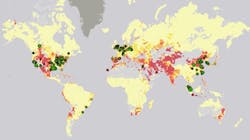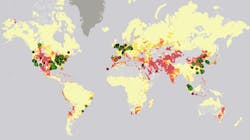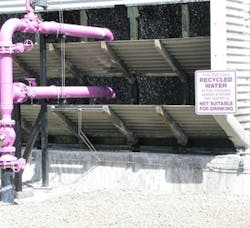The old adage what gets measured gets managed is a concept that is particularly true for water consumption at Air Products, Allentown, Pa.
Air Products consumes approximately 15 billion gallons of water each year at our facilities worldwide. We annually survey plants on water use as well as other environmental measures, and compare the results year-on-year to our environmental sustainability goals. The water data include intakes by source, discharges by destination, production volumes and contaminants (where collected). We then calculate consumption as intakes less discharges to the same source. For example, water that comes from and returns to a specific water body is not counted as consumption. This is particularly relevant to Air Products because much of the water we use is for plant cooling and goes back to the original source.
To evaluate performance against the company’s water goal, we subtract from the consumption the water required as a reactant or exported; this value is normalized by production so the results can be compared on an intensity basis.
In 2009, when Air Products engineers began centrally collecting water consumption data for more than 200 of our global facilities, opportunities to reduce water use quickly came to light. For example, by comparing expected and actual water use per unit production, we discovered leaking pipes at some older facilities; these were promptly repaired.
That same year, the company set a goal to cut consumption of controllable water — which excludes water used as a reactant or exported to customers as steam or water — on an indexed basis by 10% by 2015. Through plant efficiency improvements, facility-level assessments and use of recycled water, we met this water reduction goal four years ahead of schedule.
Improving Process Efficiency
The manufacture of hydrogen via steam methane reforming (SMR) accounts for more than half the water Air Products consumes each year. In the SMR process, water is used in two steps: to reform the methane to carbon monoxide and hydrogen, and then to shift the carbon monoxide to carbon dioxide. On a stoichiometric basis, 0.55 gallons of water are needed to make each pound of hydrogen.
Because the SMR reaction is exothermic, water also is required for cooling. The cooling towers at our plants have varying levels of efficiency and water loss as well as different discharge requirements. Overall water consumption for hydrogen production through SMR, including water used for in-plant cooling, is approximately 4.1–5.5 gallons per pound of hydrogen produced, based on data from the U.S. Dept. of Energy’s Lawrence Livermore National Laboratory [1].
SMR exemplifies the “water-energy nexus”— water is required to make hydrogen, which in turn is used to remove sulfur from crude oil to produce cleaner-burning fuels. Air Products’ energy efficiency, greenhouse gas emissions and water goals are all related through this nexus. Using a 2007 baseline, the company has set goals to both increase energy efficiency and reduce greenhouse gas emissions by 7% on an intensity basis at hydrogen/syngas (HyCO) and air separation facilities by 2015. By improving energy efficiency, our water consumption and greenhouse gas emissions will decrease on an intensity basis. We have made progress on all these goals, including cutting the amount of energy consumed per unit production at hydrogen facilities, resulting in lower water consumption on an intensity basis.
Another significant portion of the water consumed by Air Products each year goes for cooling air separation units (ASUs). In these facilities, air is compressed so cryogenic distillation then can fractionate nitrogen, oxygen and argon; in many cases, additional compression is used to liquefy products. This compression generates a significant amount of heat that is removed through water-cooled heat exchangers, necessitating cooling towers at each ASU. As at the hydrogen facilities, our engineers have improved the energy efficiency of the ASUs and brought new, more-efficient plants online, thus decreasing the company’s water consumption.
We also have initiated a series of plant-level water use reviews at representative facilities around the world. Done in conjunction with GE Water, these “water assessments” bring personnel from the two companies together to evaluate plant operations to identify opportunities to save water and reduce costs. During the assessment process, the team tours the plant, confirms piping and water flows, and pinpoints specific projects that can cut water consumption. By the end of the assessment, the team has come up with a list of recommended projects along with their estimated costs and benefits so Air Products can determine the next steps and develop action plans.
Through this program we have assessed most of our major HyCO and ASU facilities, including plants in the U.S., Canada, Brazil, the United Kingdom, Poland, Spain, the Netherlands, China, Korea and Taiwan. The assessment teams have identified ways to save on average 5–10% of the water being used at these plants. Recommendations for reducing water consumption typically include increasing cooling tower cycles, optimizing water pretreatment systems, capturing condensates and reject water from treatment processes, and recycling water. We share the results of these assessments company-wide through our plant process engineering organization so similar facilities can benefit from the opportunities identified.
Our work with GE Water builds on the two companies’ long-standing efforts to decrease costs associated with water use and treatment. For many years, GE Water has been our primary provider of water treatment services and chemicals and has had annual incentives to reduce consumption and costs. Through process improvement projects identified and implemented jointly by the companies, Air Products has saved millions of gallons of water and millions of dollars in associated water and treatment costs.
Prioritizing Plant Assessments
Members of Air Products’ water team spearhead the assessments and closely monitor water consumption. This team consists of representatives from our operations, environmental, procurement and sustainability groups and includes a GE Water representative. Most recently, the water team used geographical information system (GIS) mapping to evaluate our facilities based on the risk of water stress.
The team mapped water consumption for Air Products’ global production facilities against data from the Aqueduct database of the World Resource Institute (WRI). The visual tool, which took the form of a GIS map, integrated water consumption at our facilities with WRI data on drought severity, baseline water stress, groundwater stress and other water-related factors. Circles represent our facilities, with circle size indicating a plant’s absolute consumption of water (Figure 1). Color-coding shows the relative consumption on a unit-of-production basis as a percentage of water available. By looking at this map, the water team quickly could identify those facilities in water-stressed areas that were consuming a large or disproportionate amount of water. These sites were recommended for further evaluation and water assessments based on water stress and consumption.
Figure 1. Map shows company’s plants in water-stressed areas, with size of circles representing amount of water taken and color indicating relative consumption on a unit-of-production basis as a percentage of water available.
Dark green = low (<10%); Green = low to medium (10–20%); Yellow = medium to high (20–40%); Orange = high (40–80%); and Red = extremely high (>80%)
Using Recylced Water
Air Products operates about 20% of its facilities in water-stressed areas and looks for alternative water sources for these plants. For example, the management team at our facility in Santa Clara, Calif., learning of a potential source of recycled water that could replace potable water in the cooling tower, saw a great opportunity to reduce operating costs and help with environmental and public concerns in a drought-ridden part of California. The plant now saves 62 million gallons of potable water every year by using recycled water (Figure 2). In addition, the cost of the recycled water is less than that of fresh water, enabling the plant to cut water expenses by about half. These results have provided an incentive for the City of Santa Clara to expand its recycled water infrastructure for other consumers.
Air Products pursued a similar opportunity at another California facility. By teaming up with the Central Basin Municipal Water District, the wholesale supplier of water for 23 cities in Los Angeles County, engineers at our Santa Fe Springs ASU plant replaced 73 million gallons of potable water used in the site’s cooling tower each year with recycled water. This approach put 225 acre-feet of potable water back into the community’s water supply — enough to supply hundreds of families.
The use of recycled water also was a key consideration in the water assessment completed for our hydrogen plants in Edmonton, Alberta. The SMR units there use recycled water from the local municipality. The water entering the plant is of low quality but reliable operation of the boilers that generate steam for the SMR shift reactions demands very high quality water. Therefore, the boiler feedwater (BFW) must be treated to prevent scale formation, silica volatilization and condensation, and corrosion in the boiler. Treatment also is required to remove particulate matter.
BFW treatment occurs in two steps: the water is dosed with chemicals and treated using reverse osmosis (RO) to remove most of the ions, and then the product water from the RO system is polished via ion exchange using a salt solution. Approximately 30% of the raw water purchased is discharged as wastewater that consists of RO reject and process waste.
When the water assessment team at Edmonton met to identify opportunities to cut water consumption and water-related operating costs, its primary focus was on managing the quality of the incoming water. As a result, most of the opportunities the team identified focused on reducing or re-using the RO reject water. Suggestions included adding a scavenger to the RO phase and finding alternative uses for the reject water. The team also recommended improving the water treatment system by optimizing chemical feed points, installing a bulk chemical system and automating chemical injection for water treatment. Additional studies were proposed, including optimizing RO recovery, improving microbiological control and modifying the plant’s supply chain for water supply and export. Since the water assessment was conducted, water consumption at Edmonton has decreased by 12% on an intensity basis.
These programs to reduce water consumption, as well as those aimed at improving the efficiency of our use of other resources, are part of the company’s risk management efforts. Air Products recognizes that major changes are underway with respect to resource use and availability; as the world’s population increases, so will competition for these key materials. In fact, the World Bank predicts a 40% global shortfall of water by 2030, which likely will impact water availability and costs.
Figure 2. Facility in drought-plagued area of California has replaced potable water with recycled water in its cooling tower.
Preparing For The Future
Water availability represents an operational risk to us because our facilities can’t operate without this resource. As a result, the company’s enterprise risk management process explicitly considers water. In this process, subject matter experts and stakeholders most affected by the particular risks annually review four categories of risks — business operations, strategic planning/technology, financial controls, and legal/regulatory/governance.
A corporate compliance and risk committee provides senior-level oversight to the process, helping shape the risks to be considered and ensuring ongoing periodic review of high-profile risk elements. The chief risk officer has accountability for identifying and cataloging all relevant business risks and shares responsibility for water and other environmental factors with managers specifically charged with overseeing those elements.
Our corporate risk office also administers a country risk assessment process, which evaluates a portfolio of operational and strategic risks of entry into a new country. It uses information from Verisk Maplecroft, particularly the “Global Risk and Resilience Atlas” and “Resource Security Index,” which includes water quality and stress. Water availability also is evaluated when siting new facilities.
Also as part of our enterprise risk management program, we routinely assess the risks of new operations — from grassroots projects to expansions of existing facilities. The company considers biodiversity, land use and ecosystem impacts, and evaluates a project’s potential impact on wildlife, vegetation and habitat (particularly wetlands). This assessment can influence decisions to modify the project or develop mitigation to ensure the ecological health of the region is maintained or enhanced.
Our water center of excellence (COE) follows emerging water issues. Comprised of environmental subject matter experts, the COE tracks developments in water permitting, protection and quality; most recently it has been following water curtailments in drought-stricken areas. The COE also engages with stakeholders to proactively identify water-use-reduction opportunities and sourcing strategies to avoid potential conflicts.
Air Products takes its responsibility to manage water resources in a sustainable manner very seriously. Through plant assessments, efficiency improvements and increased recycling, we have cut the amount of water needed to manufacture our products, reducing water intensity by 24% over the last four years.
JULIE O’BRIEN is sustainability director for Air Products, Allentown, Pa. Email her at [email protected].
REFERENCES
1. Simon, A., Daily, W., and White, R., “Hydrogen and Water: An Engineering, Economic, and Environmental Analysis,” U.S. Dept. of Energy, Lawrence Livermore National Laboratory, Livermore, Calif. (2010).


